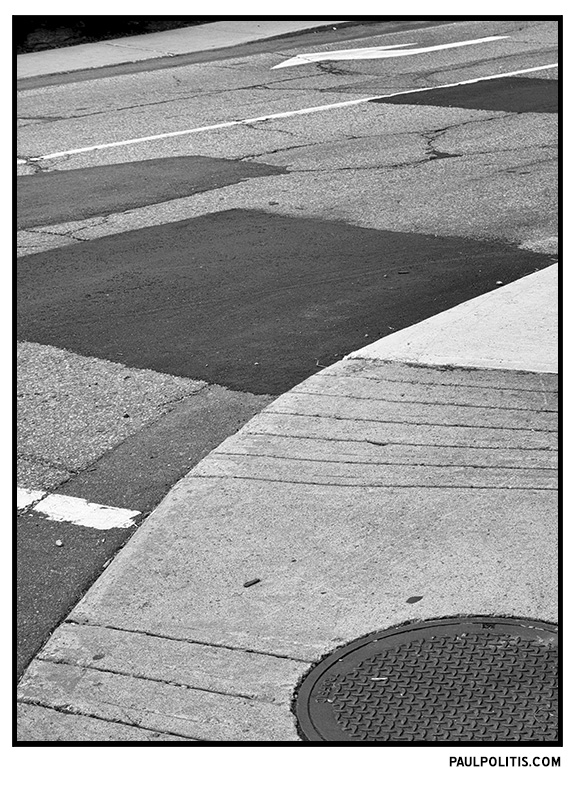

Proto Abstraction
What I call ‘proto abstraction’ can, as the name implies, be considered a way-stage on the road to abstraction proper. It typically depicts recognizable objects, but framed or lit in such a way as to draw attention, when photographed, to the resulting image’s design properties. This is achieved by a combination of bold and simplified gestalts, unusual points of view, strong lighting, close ups and other crops that direct attention to visual patterning in the image. Given, however, that this still involves recognition of everyday objects, it clearly cannot count as abstract on the forgoing account. It is formalist, rather than abstract proper.Proto abstraction was common among photographers attracted to abstraction in the other arts, but unable or unwilling to forgo the depiction of recognizable objects altogether for the sake of full blown photographic abstraction. Examples include Paul Strand’s Abstraction, Twin Lakes Connecticut (1916) and some of his early cityscapes, and Edward Weston’s 1936 series of Sand Dunes Oceano, all of which depend on an interplay of framing and strong, natural light. Other examples depend on dramatically ‘tipped up’ vertiginous points of view (Strand’s View from the Viaduct, New York (1916), László Moholy Nagy’s Berlin Radio Tower (1928) or André Kertész’s images of Washington Square in the snow (1954)).
The fact that photography proved slower than many other arts to embrace abstraction in its full-blown form may not be surprising, given how widespread the idea that photography is at bottom an art of documenting the world was and still is. Strand himself celebrated photography’s supposed ‘absolute, unqualified objectivity’, despite the fact that both his own work, and the terms in which he celebrated that of others, shows how misleading a characterization this is for the kind of distinctive personal vision he had in mind. Meanwhile leading theorists of modernism, both within and without photography, took an orthodox conception of photography more or less for granted—despite modernism’s inbuilt telos towards abstraction.
Faux Abstraction
Faux abstraction is a close cousin of proto abstraction and the two can be hard to distinguish in some cases. It consists chiefly of various strategies of estrangement and defamiliarization that isolate objects from their everyday environments or frame them in such a way as to delay or frustrate recognition of what one is looking at. What is especially interesting about faux abstraction in this context is that it depends, for its dramatic effect, on leveraging the orthodox assumptions of viewers. Photographs in this vein occasion such delight largely because it is widely assumed that photographs necessarily show us how some corner of the world looked at some moment of time. Set aside whether such assumptions are true; were they not in play, these works could not carry the charge that they do.Jaromir Funke’s Abstract Fotos (1927–9) of complicated shadow patterns are one obvious example; Minor White’s land and seascapes employing points of view (such as Bullet Holes (Middle Canyon, Capitol Reef, Utah) (1961) and Stony Brook State Park, New York (1960)) that make it hard to be sure what one is looking at—though it is clear that one is looking at something—another. It is hard to overstate how widespread faux abstract and related tendencies are in photography. The act of cutting away the rest of the world with the image edge, fundamental to much (if not all) photography, often works to estrange and abstract simultaneously.
This overlap between proto and faux abstraction explains why it is not always clear how to characterize certain images. Take Moholy-Nagy’s Radio Tower Berlin: is this proto abstract in virtue of formal design or faux abstract in virtue of strange point of view—or both? If the latter, it falls in the space where two overlap. Note, however, that such overlap is not complete. One can estrange by photographing something at an angle or speed or from a distance that frustrates recognition of what one is looking at, without this entailing that the result appears abstract. Conversely, one can abstract, by foregrounding a composition’s formal design properties, without thereby estranging. So the two remain in principle distinct, even if some images do both.
– The British Journal of Aesthetics, Volume 58, Issue 4, October 2018, Pages 385–400, October 13, 2018
By Diarmuid Costello
